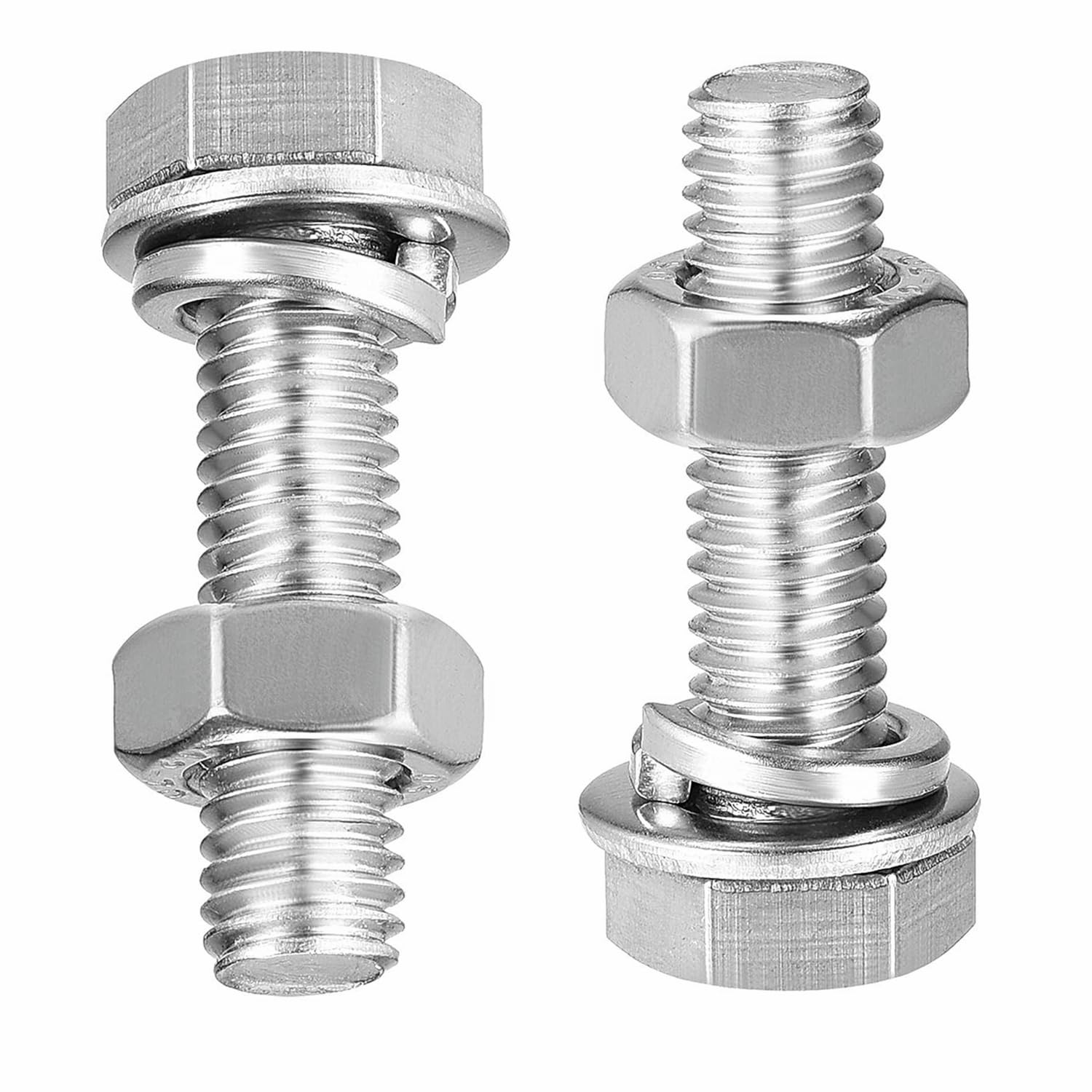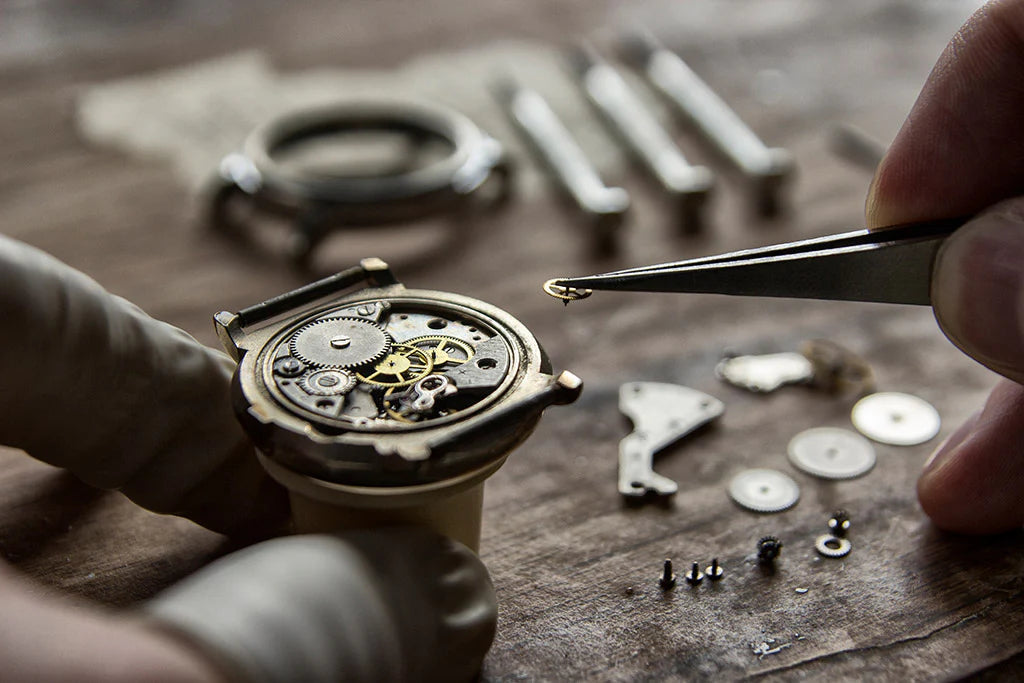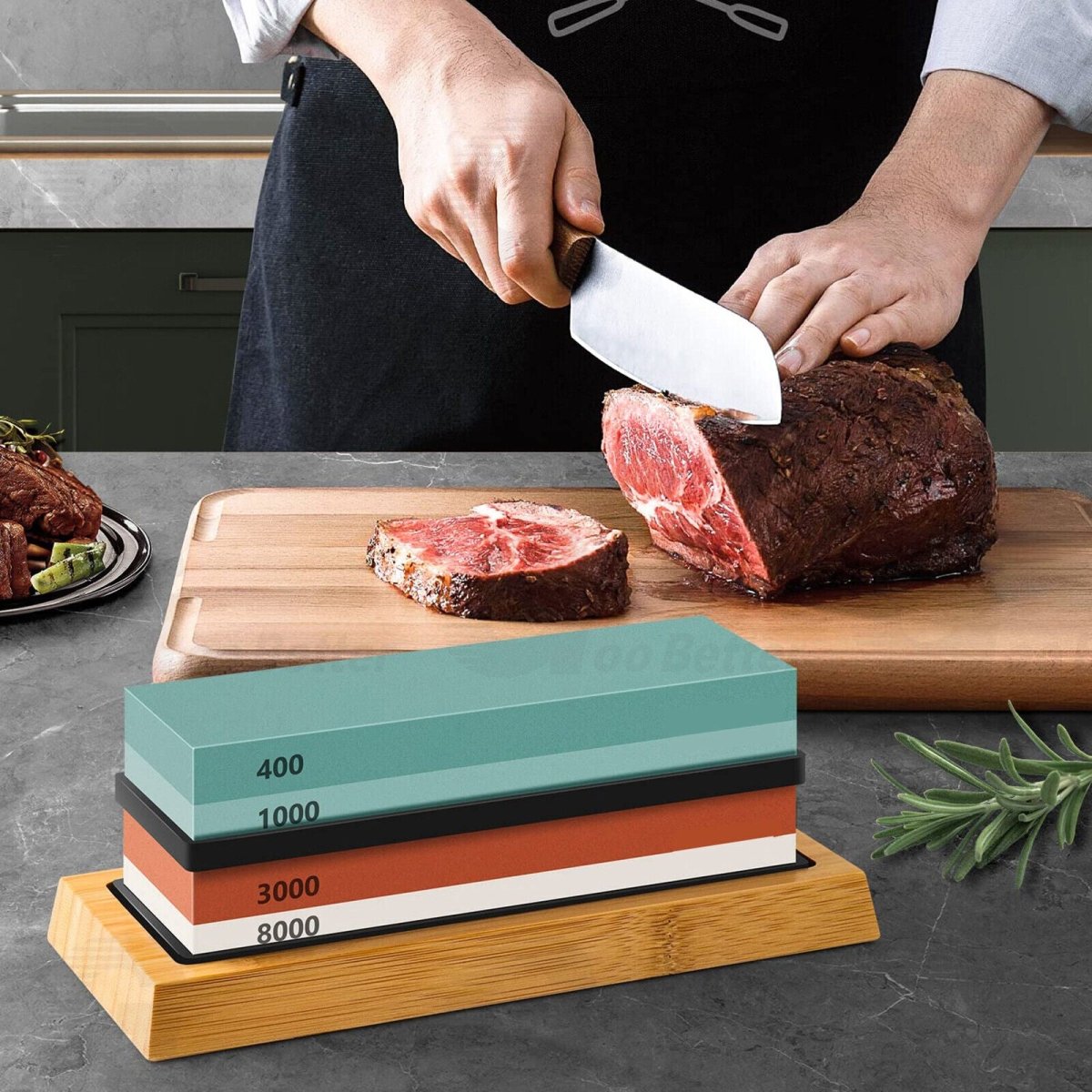Why This Difference Matters
At first glance a bolt is a bolt — threaded shank, head, and usually a nut. But in real projects, the difference between a bolt with a built-in flange versus a conventional bolt paired with a washer changes:
- How load is distributed across the clamped surface
- The risk of the head embedding or cutting through softer materials
- How assembly speed and reliability change on production lines
- Corrosion and maintenance profiles in different environments
Choosing the wrong style can lead to premature loosening, material deformation or unnecessary part complexity. That’s why we’ll unpack the details you’ll actually use when specifying fasteners for automotive, structural, electrical, furniture or general-purpose hardware tasks.
Basic Definitions: What is a Flange Bolt and What is a Washer Bolt?
Flange Bolt — definition
A flange bolt is a bolt whose head includes an integrated flange — essentially a wide circular bearing surface built into the head. The flange often has serrations (on serrated flange bolts) to improve resistance to loosening by biting into the mating surface. Flange bolts are commonly used where a washer would otherwise be needed, offering a simplified single-part solution.
Washer Bolt — definition
A washer bolt (not an industry-standard term, but commonly used in trade) usually refers to a conventional bolt (e.g., hex bolt) paired with a separate washer. The washer spreads the load, protects the surface and can be of various types — flat, spring/lock, conical, fender, or sealing washers.
Note: Some people call flange bolts “washer head bolts” informally; the critical distinction is whether the bearing surface is integrated (flange bolt) or separate (bolt + washer).
Design & Structural Differences
Let’s compare geometry, contact area, and mechanical consequences.
Head Geometry & Contact Area
Flange bolt: The flange increases the head-to-surface contact area — typically the flange diameter is several times the head diameter (depending on bolt size). This larger bearing area reduces compressive stress on the clamped material.
Bolt + washer: Using a washer lets you choose the washer diameter and material to match the substrate. A large washer can outperform a small flange if a greater bearing area is required.
Serrations & Anti-Rotation Features
Many flange bolts come with serrated or toothed faces under the flange. Those serrations help resist rotation by biting into the mating surface (especially useful in sheet metal or light structural connections). For bolt+washer combinations, you can use a serrated washer or a lock washer to achieve similar anti-rotation.
Assembly Convenience
Flange bolts simplify assembly: one part, no separate washers to handle. In production settings this reduces assembly time and inventory complexity. Conversely, separate washers give flexibility — you can choose a sealing washer, a larger bearing washer, a nylon insulating washer, or a spring washer depending on needs.
Materials, Grades and Finishes — How They Affect Flange & Washer Bolts
Material selection is a key factor. The same nominal bolt shape behaves differently when made of different grades or finishes.
Common Materials & Strength Grades
- Carbon steel (Grade 4.8 / 8.8 etc.) — economical, common for general hardware.
- Alloy steel (10.9, 12.9) — used where higher tensile strength is required.
- Stainless steel (A2 / A4) — corrosion resistance for outdoor, marine or food applications; lower tensile strength than high-grade alloy unless specified.
- Brass / bronze / nylon — specialty uses (electrical conductivity, anti-galling, or isolation).
Finishes and Corrosion Protection
Common finishes include zinc plating, hot-dip galvanizing, black oxide, nickel plating and various passivations for stainless steel. For a flange bolt, the integrated flange is treated like the rest of the head; for bolt+washer, ensure washers have the same corrosion resistance or slightly better to avoid bimetallic corrosion in certain environments.
Practical note
When using our HomeDIYer Flange Bolt Kit, check the spec sheet for material grade and finish. For outdoor or damp environments, prefer A4 stainless or properly galvanized bolts to extend service life.
Mechanical Performance & Torque Behavior
This is where the rubber meets the road. How does flange vs washer affect preload, torque-tension relationship, and joint reliability?
Torque-Tension Relationship
Torque applied at the head translates into axial preload (clamping force) on the joint. Friction under the head is a big variable. A larger bearing surface (flange) distributes load and generally reduces compressive stress on the clamped part, but it also changes the frictional behavior.
| Metric | Flange Bolt | Bolt + Washer |
|---|---|---|
| Contact Area | Fixed, built-in flange | Variable (choose washer size) |
| Friction under head | Set by flange surface texture (may be serrated) | Set by washer material and finish |
| Preload consistency | Good for repeatable production (one part) | Good if washer controlled, but adds assembly variable |
Joint Fatigue & Stress Distribution
Flange bolts help reduce local crushing and indentation on softer materials (like plastics or thin sheet metal). With a washer, you can choose a larger diameter or a specialized backing plate to spread the load over a larger area, which is useful for composite materials or wood substrates.
Installation, Torque Specs & Best Practices
A good assembly practice determines whether the fastener lasts or fails early. Here are practical guidelines.
Torque Tables (Representative)
Below is a simplified torque table for common metric sizes (torque values vary by material, lubrication, thread condition — these are approximate for clean, dry threads and medium-grade steel).
| Bolt Size | Tightening Torque (Nm) — Grade 8.8 | Notes |
|---|---|---|
| M6 | 10–12 Nm | Use threadlocker for vibration |
| M8 | 24–27 Nm | Standard assembly torque |
| M10 | 45–55 Nm | Ensure proper wrench size |
Washer vs Flange: Implication for Torque
Flange bolts reduce the need for separate washers (so head friction becomes the dominant variable). If using a washer, friction under the washer may be lower or higher depending on washer finish. For repeatable torque-to-tension in production, use calibrated torque tools and consistent lubrication policies.
Installation Best Practices
- Always clean mating surfaces of paint, burrs and oil where necessary.
- Use a torque wrench to achieve specified preload; avoid “tight by hand.”
- When replacing flange bolts, avoid reusing if flange is deformed.
- If vibration is present, consider serrated flange or locking solutions (nyloc nut, threadlocker, prevailing torque nuts).
Common Use Cases & Industry Applications
Both flange bolts and bolt+washer combos are widely used — but each tends to dominate in certain applications.
Where Flange Bolts Shine
- Automotive assemblies — cylinder head bolts, body panels, brackets (speed and reduced part count).
- Sheet metal assemblies — thin gauge steel where flange distributes load.
- Appliances & enclosures — repeated assembly/disassembly with consistent bearing required.
Where Bolt + Washer Is Preferred
- Wood and composite substrates — use large washers or plates to prevent pull-through.
- Sealed joints — use sealing washers (rubber or gasket washers) for fluid-tight assemblies.
- Insulated applications — use nylon or insulating washers for electrical isolation.
In short, flange bolts reduce steps and part numbers; bolt+washer offers flexibility. The right choice depends on substrate, environmental conditions, and assembly process.
Comparative Tables & Selection Matrix
Quick Decision Matrix
| Requirement | Prefer Flange Bolt | Prefer Bolt + Washer |
|---|---|---|
| Speed of assembly | ✔ | |
| Large bearing area required | ✔ (choose washer size) | |
| Sealing required | ✔ (use gasket washer) | |
| Anti-rotation in sheet metal | ✔ (serrated flange) | ✔ (serrated washer) |
| Electrical insulation | ✔ (insulating washer) |
Specification & Performance Comparison
| Attribute | Flange Bolt | Bolt + Washer |
|---|---|---|
| Part Count | Lower | Higher |
| Flexibility | Lower (fixed flange) | High (choose washer) |
| Cost (per joint) | Often lower due to fewer parts | Could be higher if special washers used |
| Inventory Complexity | Lower | Higher |
| Customization | Limited | High |
Sizing, Standards & Specification Notes
Flange bolts and traditional bolts follow metric (ISO) or imperial (ANSI/ASME) standards for thread dimensions, pitch and head sizes. When specifying, include:
- Diameter and pitch (e.g., M8 x 1.25)
- Length (threaded portion measurement standard)
- Material grade (e.g., 8.8, 10.9 or A2-70 stainless)
- Finish (zinc, galvanize, black oxide, etc.)
- Flange diameter or washer diameter where relevant
For replacement or procurement, consult product datasheets (our HomeDIYer flange bolt kit includes spec charts for M6/M8/M10 sets).
Cost, Sourcing and Inventory Considerations
From an operations perspective, the choice between flange bolts and bolt+washer combos affects:
- SKU count and bin space
- Pick-and-place speed on assembly lines
- Vendor consolidation and bulk pricing
For small shops and DIYers, a mixed inventory (flange bolts for common sizes plus a small assortment of washers) is often the most practical. For production, standardizing on flange bolts where acceptable can reduce labor costs.
Buying tip: Kits like HomeDIYer 549pcs Flange Bolt Kit bundle multiple sizes and fastener types for a lower per-piece cost and simplify procurement for repair shops and small manufacturers.
Inspection, Maintenance & Replacement Guidelines
Regular inspection reduces failures. Recommended checks:
- Visual inspection for corrosion or flange deformation
- Torque checks for critical joints (every service interval)
- Replace bolts showing thread galling or head stripping
- Replace one-time-use safety fasteners (if used) after service
If you see flange flaring or cracks under the flange, replace the bolt — the bearing surface is compromised and will not reliably maintain preload.
Case Studies & Real-World Examples
Case Study 1 — Auto Repair Shop: Speed vs Customization
An independent auto shop switched to serrated flange bolts for several repeated bracket repairs. The shop reported a 12% reduction in assembly time per repair and fewer missing washers. However, for interior dashboard assemblies where plastic surfaces required insulation, the shop still used bolt+washer combos to prevent stress concentrations.
Case Study 2 — Small Manufacturer: Inventory Simplification
A small manufacturer standardized on flange bolts for non-critical enclosures and kept a small selection of large-diameter washers for wooden or composite panels. The consolidation reduced SKUs by 28% and simplified reorder triggers.
Case Study 3 — DIYer Workshop
A DIY furniture maker used bolt+washer combos for a wooden bench to prevent crushing of wood fibers. Excessive flange pressure caused indentation; switching to a larger diameter washer solved the issue without changing bolt size.
FAQ — Frequently Asked Questions
Q1: Are flange bolts stronger than bolts with washers?
A: Strength in terms of tensile capacity is a function of material and thread size, not whether the head is flanged. However, flange bolts reduce local bearing stress which can improve joint performance on softer substrates. For ultimate bearing area, a large washer will outperform a small flange.
Q2: When should I use serrated flange bolts?
A: Use serrated flange bolts in sheet metal applications to prevent rotation where a lock washer or threadlocker is undesirable. They bite into the surface, resisting loosening under vibration.
Q3: Can I reuse flange bolts?
A: You can often reuse flange bolts if the flange and threads are intact and undamaged. But if serrations are worn or the flange is deformed (flattened or cracked), replace the bolt to ensure proper seating and torque behavior.
Q4: Do flange bolts reduce the need for a locking washer?
A: Serrated flange bolts can reduce the need for some locking devices by providing higher friction at the head. However, in high-vibration or safety-critical joints, a secondary locking method (nyloc nut, threadlocker) is still recommended.
Q5: Are flange bolts suitable for painted surfaces?
A: Serrated flanges may damage paint upon installation. Use plain flange bolts or use protective washers if cosmetic finish is a concern. In corrosion-critical painted surfaces, make sure the finish on the bolt and washer match to avoid galvanic corrosion.
Q6: What's the difference between a flange bolt and a flange head screw?
A: A screw typically drills or forms threads in the substrate, while a bolt is used with a nut or tapped hole. A flange head screw behaves similarly to a flange bolt in terms of bearing area but is used in different thread-forming contexts.
Q7: Can I substitute a flange bolt for a bolt+washer in critical structural joints?
A: Only if the flange provides sufficient bearing area and the material-grade/finish are specified for the application. Structural joints often require calculated bearing and stress checks; consult an engineer for load-critical applications.
Q8: Are flange bolts standard in metric and imperial sizes?
A: Yes. You can find flange bolts in metric (M-series) and imperial (UNC/UNF) threads. Specification sheets list flange diameters and head dimensions for design reference.
Q9: How do I pick between zinc-plated and hot-dip galvanized for flange bolts?
A: Zinc plating provides limited corrosion resistance (best for indoor use), whereas hot-dip galvanizing is far more robust for outdoor and marine environments. Choose A4 stainless or hot-dip galvanizing for long-term outdoor exposure.
Q10: Does HomeDIYer sell specialty washers for high-load applications?
Yes.HomeDIYer offers kits and accessories — if you buy the M6/M8/M10 Flange Bolt Kit, consider pairing with our flat bearing washers or sealing washers for critical joints.
Conclusion & Recommendation
The difference between a flange bolt and a washer bolt is not merely semantics — it is a practical engineering choice that affects load distribution, assembly speed, inventory complexity and long-term reliability.
Choose flange bolts if:
- You want faster assembly and fewer parts.
- You are working with sheet metal or need light anti-rotation via serration.
- You require a compact assembly with moderate bearing area.
Choose bolt + washer if:
- You need larger bearing area or specialized washer features (sealing, insulation, larger diameter).
- You work with softer substrates (wood, composite) that require load spreading.
- You want the flexibility to change washer types without changing bolts.
For many workshops and small manufacturers, a blend of both is the best approach — use flange bolts where acceptable and keep a selection of washers for special cases. If you want to simplify your inventory while retaining flexibility, consider the HomeDIYer 549pcs Flange Bolt Kit — it covers common sizes and includes nuts and washers so you can adapt as needed.








